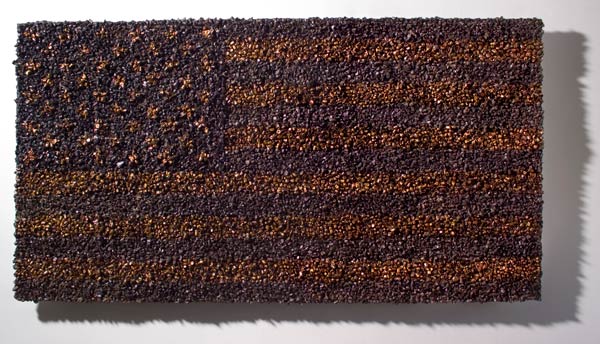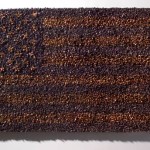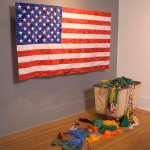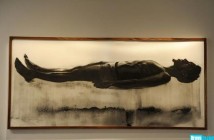DAVE COLE @ JUDI ROTENBERG GALLERY
“There is no war, then, without representation, no sophisticated weaponry without psychological mystification. Weapons are not just tools of destruction but also of perception… “
- Paul Virilio “Military Force is Based Upon Deception.”
We are constantly inundated with images of war. It is a central part of the American experience. War created our country and our culture wrestles with the ramifications of its presence on a day-to-day basis thanks to the current Iraq war. Even as children we “play” at war. Granted, I grew up on military bases so perhaps my own childhood was somewhat skewed by the actual presence of the military. I imagine that this reinforced the notion of war as “play” (at least for me). However, game play (war, chess, checkers, what have you) ultimately acclimates us to the very presence of war or at the very least the reality of struggle we will experience as active participants in an “adult” world.
Our current cultural moment, unfortunately, does have a war going on with very real consequences, and very real people sacrificing themselves. It is this type of cultural cloud that hangs over the work of Dave Cole currently hanging in the Judi Rotenberg Gallery. Cole’s work attempts to navigate the struggle between war, play, childhood and commodification. There are moments where he is successful at presenting these ideas. There are a series of children’s outfits ranging from onesies to booties to a military style jacket all made from (presumably surplus) first Iraq War era Kevlar material. While the tailoring here is worthy of a contestant on Bravo’s Project Runway the selection of outfits seems haphazard. There is a consistency throughout them; they are all children's outfits, yet the range offered up diminishes the power inherent in each individually. What is initially a frankly disturbing conception (bulletproof Kevlar material woven into icons of childhood) gives way to thoughts of “isn’t that clever but so what?” This is really a question of editing. I understand the motivation to show the breadth of possibilities but in this case less would be more.
Another piece that is in conversation with the work noted above is Baby Bottle after MIL-B-16755B, Military Specification: Bottle, Nursing from 2008. This consists of numerous cast metal baby bottles mounted on the wall. It mines the same conceptual ground of childhood and the military (the alpha-numerical designation in the title is the Department of Defense specification identifier for a baby bottle) but fails for a different reason. It is a little obvious. It’s clever but it is unfortunately the least interesting aspect of the show.
What pushes the show to another level is when Cole reconstructs, reconfigures and re-imagines the ultimate American icon: our flag. He does this in two ways. First, he constructs flags out of recovered bullets and bullet fragments. These flags are dun coloured with the stripes and stars burnished to stand in contrast. They are flat and dark, weighted down by their materials and completely immobile. It is a symbol reduced to its symbolic status. They do not live or breath as one imagines a cloth flag moving in the wind. The flag is all too often evoked as an arbiter of patriotism (note the innumerable attempts to ban its burning). These are flags that refute any attempts to command or inspire. It is hard to imagine the mythic Betsy Ross moment with these flags. What they do is question and provoke. There is a respect in their creation but I sense that they are also reflective of the artist’s personal struggle with this symbol. Cole’s other flags stand in contrast to these. These are flags (literally every flag of every nation that is part of the United Nations) cut and re-sewn into a new much larger flag piece entitled Flags of the World. There is a scaled down version of the main piece, which is far too large to fit into the gallery. This is a piece that I felt was successful in its execution and its concept yet as a work unto itself felt incomplete. There is a video of the making of the piece playing in the gallery. I imagine that the main piece is quite powerful in person. One gets the sense of accomplishment and obsessiveness inherent in Cole’s work when watching him and his team cut and sew. But I wondered why that size? What is the message inherent in that scale? What is he referencing? It did make me think of the giant-sized flags that are flown over car lots. It is the convergence of the car dealerships, American patriotism and internationalism? I do like the idea of constructing one giant American flag out of numerous world flags but then what? It exists as a symbol constructed of other symbols but is it meant to evoke thoughts of immigration, world culture, America as unifier? What is going on here? I quite like the piece in that it provokes these questions. I am on the fence about wanting to be guided by the artist and desiring my own path through its meaning.
Cole’s work walks the line between being didactic and being oblique. Perhaps in his seemingly obsessive manner of creation the concepts are muddied? Is he in too deep when constructing the work? The concepts are there and so is the skill level but where they converge is the crux of the problem. I find myself returning to certain pieces in my mind and thinking deeply about them. The work asks questions of cultural identity, war and nationalism. What are our symbols and how do they function in how we act both as citizens and as a nation? These are big questions and tackling them effectively is not easy. But I am reminded of Terry Smith’s musings on art. According to Smith art is “a productive activity in which actual materials are transformed in order to communicate, or invite the consumption of, immaterialities such as image, feelings and ideas."1 Cole’s work touches upon all of these things. We are implicated in his work. These are our cultural objects and we bear some responsibility for how they are used and interpreted.
- Dave Cole, Bullet Flag, Recovered Bullets and Bullet Fragments, 2008.
- Dave Cole, Flags of The World Study #1 (1:4 scale), United Nations official 192 piece ‘Flags of the World’ set, cut and re-sewn, with mixed media, 2007
- Dave Cole, installation view.
[1] - see Critical Terms for Art History, eds. Robert S. Nelson and Richard Shiff, U. of Chicago Press, 2003
"Dave Cole: All American" is on view September 4 - October 12, 2008 at Judi Rotenberg Gallery.
All images are courtesy of the artist and Judi Rotenberg Gallery.
Photos by Casey McNamara.







